-
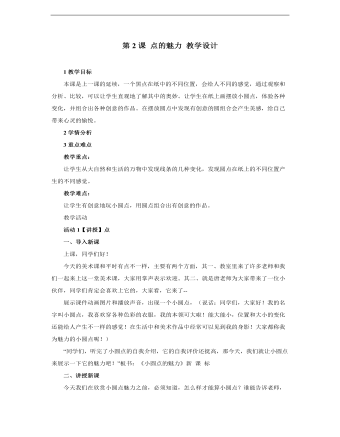
小学美术人教版四年级下册《第2课点的魅力2》教学设计说课稿
一、导入新课上课,同学们好!今天的美术课和平时有点不一样,主要有两个方面,其一、教室里来了许多老师和我们一起来上这一堂美术课,大家用掌声表示欢迎。其二、就是唐老师为大家带来了一位小伙伴,同学们肯定会喜欢上它的,大家看,它来了--展示课件动画图片和播放声音,出现一个小圆点,(说话:同学们,大家好!我的名字叫小圆点,我喜欢穿各种色彩的衣服,我的本领可大啦!能大能小,位置和大小的变化还能给人产生不一样的感觉!在生活中和美术作品中经常可以见到我的身影!大家都称我为魅力的小圆点呢!)

新人教版高中英语选修2Unit 1 Science and Scientists-Discovering useful structures教学设计
The grammatical structure of this unit is predicative clause. Like object clause and subject clause, predicative clause is one of Nominal Clauses. The leading words of predicative clauses are that, what, how, what, where, as if, because, etc.The design of teaching activities aims to guide students to perceive the structural features of predicative clauses and think about their ideographic functions. Beyond that, students should be guided to use this grammar in the context apporpriately and flexibly.1. Enable the Ss to master the usage of the predicative clauses in this unit.2. Enable the Ss to use the predicative patterns flexibly.3. Train the Ss to apply some skills by doing the relevant exercises.1.Guide students to perceive the structural features of predicative clauses and think about their ideographic functions.2.Strengthen students' ability of using predicative clauses in context, but also cultivate their ability of text analysis and logical reasoning competence.Step1: Underline all the examples in the reading passage, where noun clauses are used as the predicative. Then state their meaning and functions.1) One theory was that bad air caused the disease.2) Another theory was that cholera was caused by an infection from germs in food or water.3) The truth was that the water from the Broad Street had been infected by waste.Sum up the rules of grammar:1. 以上黑体部分在句中作表语。2. 句1、2、3中的that在从句中不作成分,只起连接作用。 Step2: Review the basic components of predicative clauses1.Definition

新人教版高中英语选修2Unit 1 Science and Scientists-Learning about Language教学设计
Step 7: complete the discourse according to the grammar rules.Cholera used to be one of the most 1.__________ (fear) diseases in the world. In the early 19th century, _2_________ an outbreak of cholera hit Europe, millions of people died. But neither its cause, 3__________ its cure was understood. A British doctor, John Snow, wanted to solve the problem and he knew that cholera would not be controlled _4_________ its cause was found. In general, there were two contradictory theories 5 __________ explained how cholera spread. The first suggested that bad air caused the disease. The second was that cholera was caused by an _6_________(infect) from germs in food or water. John Snow thought that the second theory was correct but he needed proof. So when another outbreak of cholera hit London in 1854, he began to investigate. Later, with all the evidence he _7_________ (gather), John Snow was able to announce that the pump water carried cholera germs. Therefore, he had the handle of the pump _8_________ (remove) so that it couldn't be used. Through his intervention,the disease was stopped in its tracks. What is more, John Snow found that some companies sold water from the River Thames that __9__________________ (pollute) by raw waste. The people who drank this water were much more likely _10_________ (get) cholera than those who drank pure or boiled water. Through John Snow's efforts, the _11_________ (threaten) of cholera around the world saw a substantial increase. Keys: 1.feared 2.when 3. nor 4.unless 5.that/which 6.infection 7.had gathered 8.removed 9.was polluted 10.to get 11. threat

新人教版高中英语选修2Unit 1 Science and Scientists-Using langauge教学设计
This happens because the dish soap molecules have a strong negative charge, and the milk molecules have a strong positive charge. Like magnets, these molecules are attracted to each other, and so they appear to move around on the plate, taking the food coloring with them, making it look like the colors are quickly moving to escape from the soap.Listening text:? Judy: Oh, I'm so sorry that you were ill and couldn't come with us on our field trip. How are you feeling now? Better?? Bill: Much better, thanks. But how was it?? Judy: Wonderful! I especially liked an area of the museum called Light Games.it was really cool. They had a hall of mirrors where I could see myself reflected thousands of times!? Bill: A hall of mirrors can be a lot of fun. What else did they have?? Judy: Well, they had an experiment where we looked at a blue screen for a while, and then suddenly we could see tiny bright lights moving around on it. You'll never guess what those bright lights were!? Bill: Come on, tell me!? Judy: They were our own blood cells. For some reason, our eyes play tricks on us when we look at a blue screen, and we can see our own blood cells moving around like little lights! But there was another thing I liked better. I stood in front of a white light, and it cast different shadows of me in every color of the rainbow!? Bill: Oh, I wish I had been there. Tell me more!? Judy: Well, they had another area for sound. They had a giant piano keyboard that you could use your feet to play. But then, instead of playing the sounds of a piano, it played the voices of classical singers! Then they had a giant dish, and when you spoke into it, it reflected the sound back and made it louder. You could use it to speak in a whisper to someone 17 meters away.? Bill: It all sounds so cool. I wish I could have gone with you? Judy: I know, but we can go together this weekend. I'd love to go there again!? Bill: That sounds like a great idea!

新人教版高中英语选修2Unit 1 Science and Scientists-Reading and thinking教学设计
Step 5: After learning the text, discuss with your peers about the following questions:1.John Snow believed Idea 2 was right. How did he finally prove it?2. Do you think John Snow would have solved this problem without the map?3. Cholera is a 19th century disease. What disease do you think is similar to cholera today?SARS and Covid-19 because they are both deadly and fatally infectious, have an unknown cause and need serious public health care to solve them urgently.keys:1. John Snow finally proved his idea because he found an outbreak that was clearly related to cholera, collected information and was able to tie cases outside the area to the polluted water.2. No. The map helped John Snow organize his ideas. He was able to identify those households that had had many deaths and check their water-drinking habits. He identified those houses that had had no deaths and surveyed their drinking habits. The evidence clearly pointed to the polluted water being the cause.3. SARS and Covid-19 because they are both deadly and fatally infectious, have an unknown cause and need serious public health care to solve them urgently.Step 6: Consolidate what you have learned by filling in the blanks:John Snow was a well-known _1___ in London in the _2__ century. He wanted to find the _3_____ of cholera in order to help people ___4_____ it. In 1854 when a cholera __5__ London, he began to gather information. He ___6__ on a map ___7___ all the dead people had lived and he found that many people who had ___8____ (drink) the dirty water from the __9____ died. So he decided that the polluted water ___10____ cholera. He suggested that the ___11__ of all water supplies should be _12______ and new methods of dealing with ____13___ water be found. Finally, “King Cholera” was __14_____.Keys: 1. doctor 2. 19th 3.cause 4.infected with 5.hit 6.marked 7.where 8.drunk 9.pump 10.carried 11.source 12.examined 13.polluted 14.defeatedHomework: Retell the text after class and preview its language points
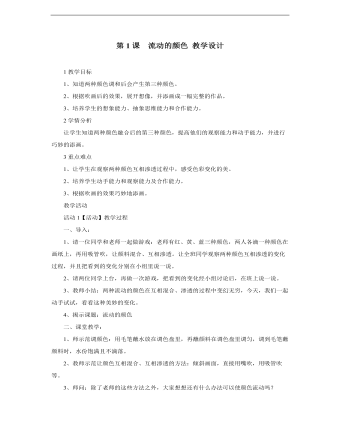
小学美术人教版二年级上册《第1课流动的颜色》教学设计说课稿
一、导入:1、请一位同学和老师一起做游戏:老师有红、黄、蓝三种颜色,两人各滴一种颜色在画纸上,再用吸管吹,让颜料混合、互相渗透。让全班同学观察两种颜色互相渗透的变化过程,并且把看到的变化分别在小组里说一说。2、请两位同学上台,再做一次游戏,把看到的变化经小组讨论后,在班上说一说。3、教师小结:两种流动的颜色在互相混合、渗透的过程中变幻无穷,今天,我们一起动手试试,看看这种美妙的变化。4、揭示课题:流动的颜色
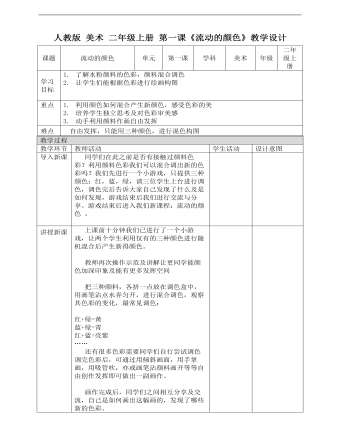
小学美术人教版二年级上册《第1课流动的颜色》教案说课稿
同学们在此之前是否有接触过颜料色彩?利用颜料色彩我们可以混合调出新的色彩吗?我们先进行一个小游戏,只提供三种颜色:红,蓝,绿,请三位学生上台进行调色,调色完后告诉大家自己发现了什么及是如何发现,游戏结束后我们进行交流与分享。游戏结束后进入我们新课程:流动的颜色 。
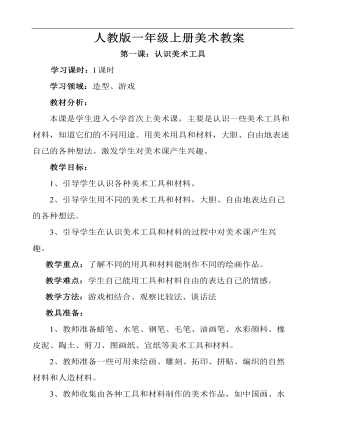
小学美术人教版一年级上册《第1课认识美术工具》教案说课稿
1、引导学生认识各种美术工具和材料。2、引导学生用不同的美术工具和材料,大胆、自由地表达自己的各种想法。3、引导学生在认识美术工具和材料的过程中对美术课产生兴趣。教学重点:了解不同的用具和材料能制作不同的绘画作品。教学难点:学生自己能用工具和材料自由的表达自己的情感。教学方法:游戏相结合、观察比较法、谈话法

乡下人家说课稿 3篇
二、教学设计的理念与思路。 阅读是个性化的过程,不能以教师的思维而取代学生思维,所以,我在引导学生阅读的时候,强调以学生为主体,让他们自读自悟,说一说感兴趣的景色,抄一抄优美的句子。关注他们情感的生成、个性的体验和生活的联系。 阅读不仅仅是人文性教育,更不可忽视的是语文基本技能的训练,课标提出这一学段的学生能"用普通话正确、流利、有感情地朗读课文"、"理解词句的意思"、"积累课文中的优美词句、精彩语段"等要求。所以我引导学生在解读课文的过程中,同时进行词语的运用,朗读的训练,写法的提炼,使人文性与工具性融为一体。 三、教学过程的安排及意图。 根据课文任务量,我将用两节课完成教学。第一节课的任务是通读课文及精读课文第1~4自然段。第二节课的任务是品读5~7自然段及识字。下面我说说第一节课的安排与意图。
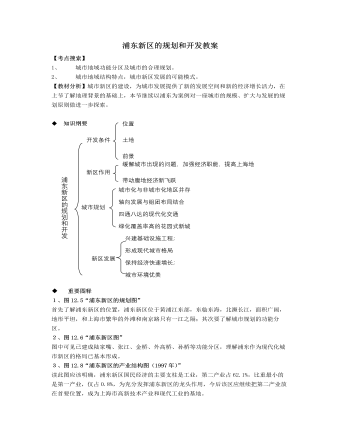
人教版高中地理选修2浦东新区的规划和开发教案
1、图12.5“浦东新区的规划图”首先了解浦东新区的位置,浦东新区位于黄浦江东部,东临东海,北濒长江,面积广阔,地形平坦,和上海市繁华的外滩和南京路只有一江之隔;其次要了解城市规划的功能分区。2、图12.6“浦东新区图”图中可见已建成陆家嘴、张江、金桥、外高桥、孙桥等功能分区,理解浦东作为现代化城市新区的格局已基本形成。3、图12.8“浦东新区的产业结构图(1997年)”读此图应该明确,浦东新区国民经济的主要支柱是工业,第二产业占62.1%,比重最小的是第一产业,仅占0.8%,为充分发挥浦东新区的龙头作用,今后该区应继续把第二产业放在首要位置,成为上海市高新技术产业和现代工业的基地。【教学内容】一、浦东新区的开发条件和作用建设城市新区是上海市发展的必然选择,建设新城区首先要选择合适的区域。
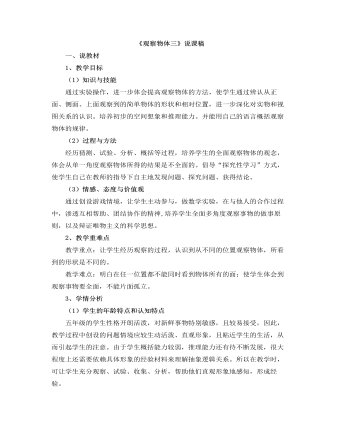
小学数学人教版五年级下册《观察物体(三)》说课稿
三、说学法学生是学习的主体,应在学习中充分发挥自己的主体能动作用,所以本节课学生主要采用以分组实践、自主探究、合作交流为主要形式的“探究学习法”,目的是通过丰富多彩的小组活动,观察实践,以合作学习促进自主探究。首先是小组合作观察药箱和其他立体图形的活动,我先让小组成员独立思考,然后组内讨论交流,达成共识,最后小组成员一齐操作。然后是小组议一议的活动,老师先引导学生:关于观察物体,你有什么新发现?学生在独立思考的基础上讨论交流,各抒己见,共同促进。组与组之间也有交流。学生合作过程中,教师适当的启发、引导,学生的学习方式主要是自主、合作和探究性的。
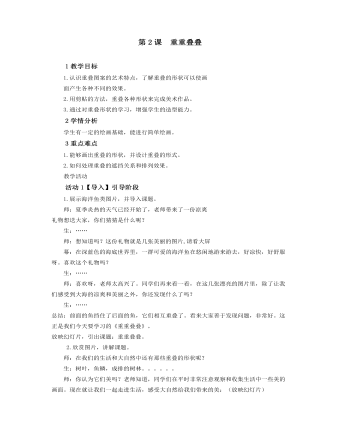
小学美术人教版二年级下册《第2课重重叠叠》教学设计说课稿
1.展示海洋鱼类图片,并导入课题。师:夏季炎热的天气已经开始了,老师带来了一份凉爽礼物想送大家,你们猜猜是什么呢?生:……师:想知道吗?这份礼物就是几张美丽的图片,请看大屏幕:在深蓝色的海底世界里,一群可爱的海洋鱼在悠闲地游来游去,好凉快,好舒服呀。喜欢这个礼物吗? 生:…… 师:喜欢呀,老师太高兴了。同学们再来看一看,在这几张漂亮的图片里,除了让我们感受到大海的凉爽和美丽之外,你还发现什么了吗?
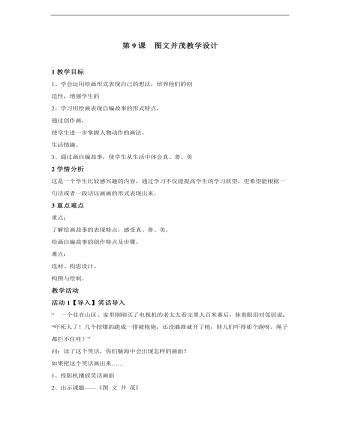
小学美术人教版六年级下册《第9课图文并茂2》教学设计说课稿
2学情分析这是一个学生比较感兴趣的内容,通过学习不仅能提高学生的学习欲望,更希望能根据一句话或者一段话以画画的形式表现出来。3重点难点重点:了解绘画故事的表现特点,感受真、善、美。绘画自编故事的创作特点及步骤。难点:选材、构思设计、构图与绘制。
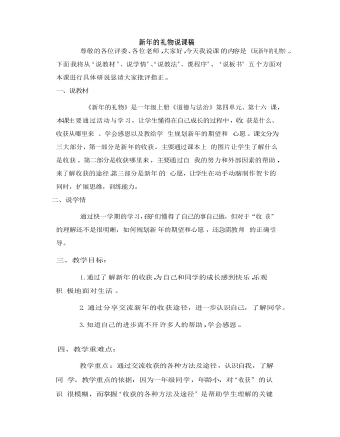
人教部编版道德与法制一年级上册新年的礼物说课稿
(3) 学生 民主评议 ,再由该位明星 把自己的名字 写在相应的星上 , 贴在圣诞树上 。(4) 圣诞老人颁发明星 证书 ,送上小礼物 ,并送上新年寄 语。(5) 学生畅谈 :你觉得这些小 明星的哪些地方最吸引你 ?你想怎 么 做,争取在接下来的评比中能成功?2 总结 :孩子们 ,能正确地认识自 己和别人优点,取长补短这是 人生最大的收获 ,也是最有意义 的新年礼物。活动四:收获哪里来一一感恩帮助过 自己的人l过渡 :看来 同学们收获的新年礼物还真不少 。你们想过没有, 这些收获是怎 么来的?除 了 自己的努力,还有 哪些人帮助过你 吗?2 学生互 动 :小组内说一说帮助过自己的人和亭 ,写在纸条上 , 放进爱心信箱 。3. 即兴发言:学 生从爱心信箱中随意抽取爱心卡 ,读一读 ,分享 那些曾经 给予他人帮助过的人和事。4. 小结 :让我们把这个爱心信箱留在班级 ,每一次得到他人的帮 助,都可以记录下来 ,投进信箱 ,让爱心充满校园 。活动五 :爱的回报一一大家帮助我成长进 步 ,我该如何回馈 ,用 行动感恩
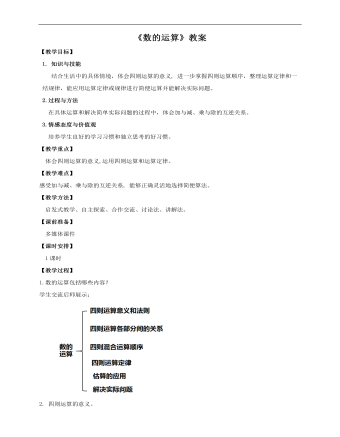
小学数学人教版六年级下册《第二课数的运算》教案说课稿
2.四则运算的意义。(1)知识梳理师:我们学过哪些运算?举例说明这些运算的含义。生:把两个(或几个)数合并成一个数的运算,叫做加法。 已知两个加数的和与其中的一个加数,求另一个加数的运算,叫做减法。 求几个相同加数的和的简便运算。 已知两个因数的积与其中一个因数,求另一个因数的运算。 师:整数、小数、分数四则运算有什么相同点?学生交流后师总结:加减法:都是把相同计数单位的数相加减。乘除法:小数乘除法把除数转化成整数再计算。分数除法要转化成分数乘法计算。师:整数、小数、分数四则运算有什么不同点?生:小数乘、除法还要在计算结果上确定小数点的位置,分数除法转化后乘的是除数的倒数。师:如果有0或者1参与四则运算,有哪些特殊情况?(学生讨论交流)生:任何数加减0都得原数。
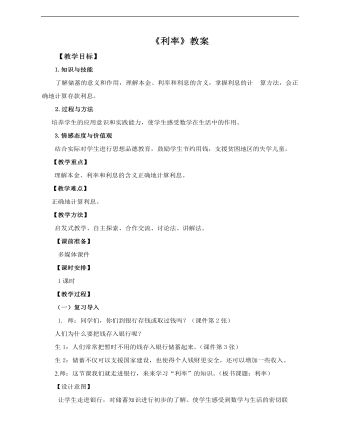
小学数学人教版六年级下册《第四课利率》教案说课稿
2.过程与方法 培养学生的应用意识和实践能力,使学生感受数学在生活中的作用。3.情感态度与价值观结合实际对学生进行思想品德教育,鼓励学生节约用钱,支援贫困地区的失学儿童。 【教学重点】 理解本金、利率和利息的含义正确地计算利息。 【教学难点】 正确地计算利息。【教学方法】启发式教学、自主探索、合作交流、讨论法、讲解法。【课前准备】 多媒体课件【课时安排】 1课时【教学过程】(一)复习导入 1. 师:同学们,你们到银行存钱或取过钱吗?(课件第2张)人们为什么要把钱存入银行呢?生1:人们常常把暂时不用的钱存入银行储蓄起来。(课件第3张)生2:储蓄不仅可以支援国家建设,也使得个人钱财更安全,还可以增加一些收入。2.师:这节课我们就走进银行,来来学习“利率”的知识。(板书课题:利率)
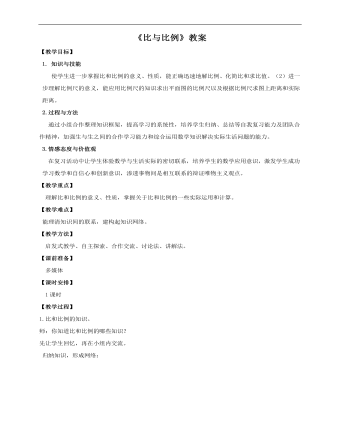
小学数学人教版六年级下册《第四课比与比例》教案说课稿
2.过程与方法 通过小组合作整理知识框架,提高学习的系统性,培养学生归纳、总结等自我复习能力及团队合作精神,加强生与生之间的合作学习能力和综合运用数学知识解决实际生活问题的能力。3.情感态度与价值观在复习活动中让学生体验数学与生活实际的密切联系,培养学生的数学应用意识,激发学生成功学习数学和自信心和创新意识,渗透事物间是相互联系的辩证唯物主义观点。【教学重点】 理解比和比例的意义、性质,掌握关于比和比例的一些实际运用和计算。【教学难点】能理清知识间的联系,建构起知识网络。【教学方法】启发式教学、自主探索、合作交流、讨论法、讲解法。【课前准备】
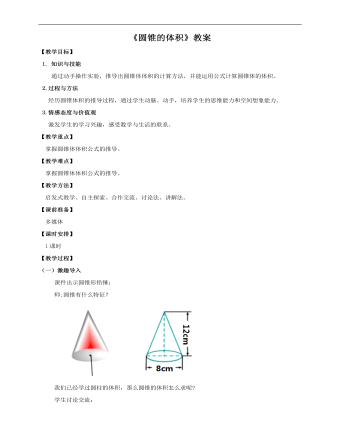
小学数学人教版六年级下册《第五课圆锥的体积》教案说课稿
(二)探究新知 1. 探究圆锥的体积的计算方法,学习例2。师:圆锥的体积和圆柱的体积有没有关系呢?圆柱的底面是圆,圆锥的底面也是圆……通过实验探究一下圆锥和圆柱体积之间的关系。小组合作探索:(1)各组准备好等底、等高的圆柱、圆锥形容器。(2)用倒沙子或水的方法试一试。(3)圆锥的体积与同它等底等 高的圆柱体积之间有什么关系?(4)小组活动,师巡视指导。2.推导圆锥体积的计算方法。 (1)课件演示等底等高的圆柱和圆锥
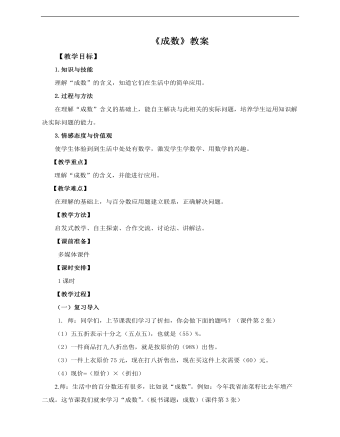
小学数学人教版六年级下册《第二课成数》教案说课稿
(一)复习导入 1. 师:同学们,上节课我们学习了折扣,你会做下面的题吗?(课件第2张)(1)五五折表示十分之(五点五),也就是(55)%。 (2)一件商品打九八折出售,就是按原价的(98%)出售。(3)一件上衣原价75元,现在打八折售出,现在买这件上衣需要(60)元。(4)现价=(原价)×(折扣)2.师:生活中的百分数还有很多,比如说“成数”。例如:今年我省油菜籽比去年增产二成。这节课我们就来学习“成数”。(板书课题:成数)(课件第3张)【设计意图】 “折扣”与“成数”虽然运用不一样,但解决方法大致相同,复习不仅可以起到巩固作用,也能让学生对新知的解决有一些铺垫。(二)探究新知 1、探究成数的含义以及成数和百分数的关系。(课件第4张)(1)农业收成,经常用成数来表示。你知道什么是成数吗? 生1:成数表示一个数是另一个数的十分之几,通称“几成”。“一成”就是十分之一,改写成百分数是10%。(2)填一填。(课件第5张)“二成”就是(十分之二),改写成百分数是(20%);“三成五”就是(十分之三点五),改写成百分数是(35%)。“四成三”就是(十分之四点三),改写成百分数是(43%);“六成五”就是(十分之六点五),改写成百分数是(65%)。(3)把下面的成数改写成百分数。 (课件第6张)三成=(30)% 四成六=(46)% 九成九=(99)% 二成五=(25)% 一成二=(12)% 七成三=(73)%
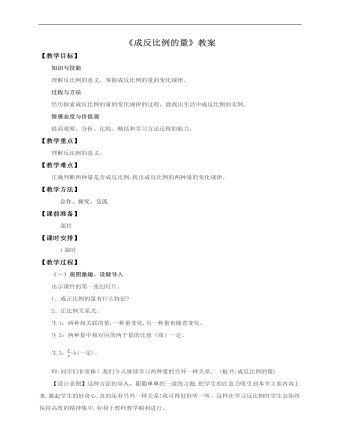
小学数学人教版六年级下册《第二课成反比例的量》教案说课稿
【教学过程】(一)观图激趣、设疑导入 出示课件的第一张幻灯片。1、成正比例的量有什么特征?2、正比例关系式。生1:两种相关联的量,一种量变化,另一种量也随着变化。生2:两种量中相对应的两个量的比值(商)一定。生3:=k(一定)。师:同学们非常棒!我们今天继续学习两种量的另外一种关系。 (板书:成反比例的量)【设计意图】这种方法的导入,简简单单的一道练习题,把学生的注意力吸引到本节主要内容上来,激起学生的好奇心,真的还有另外一种关系!我可得好好听一听。这样在学习反比例时学生会始终保持高度的精神集中,有利于教师教学顺利进行。(二)探究新知教学例2,探究反比例的意义,理解成反比例的量。1、出示PPT课件回答问题。杯子的底面积与水的高度的变化情况如下表。 杯子的底面积/cm²1015203060…水的高度/cm302015105…观察上表,回答下面的问题。(1)表中有哪两种量?(2)水的高度是怎样随着杯子底面积的大小变化而变化的?(3)相对应的杯子的底面积与水的高度的乘积分别是多少?生1:表中有杯子的底面积和水的高度这两种量。生2:从表中可以看出:水的高度随着杯子的底面积的变大而不断变小,这两种量是相关联的两种量。生3:我来回答(3),相对应的杯子的底面积与水的高度的乘积分别是:10×30=15×20=20×15=30×10=60×5=…=300。生4:乘积一定。师:底面积与高的乘积表示的是什么?生:水的体积。(板书)师:你会算出水的体积吗?生:会。(学生计算,教师出示课件订正)2、揭示反比例的意义。师:积是300,实际就是倒入杯子的水的体积。同学们能用式子表示出它们的关系吗?生:它们的关系是:底面积×高=体积。师:同学们,我们用概括正比例意义时的方法来概括一下反比例的意义吧!生:像这样,两种相关联的量,一种量变化,另一种量也随着变化,如果这两种量中相对应的两个数的乘积一定,这两种量就叫做成反比例的量,它们的关系叫做反比例关系。(板书反比例的意义)3、用字母表示反比例关系:xy=k(一定)。(板书)4、牛刀小试。锅炉房烧煤的天数与每天烧煤的吨数如下表: 每天烧煤的吨数/吨11.522.53烧煤的天数/天3020151210(1)表中有哪两种量?它们是不是相关联的量?(2)写出几组这两种量中相对应的两个数的积,并比较大小,说一说这个积表示什么。(3)烧煤的天数与每天烧煤的吨数成反比例吗?为什么?【参考答案】 (1)每天烧煤的吨数和烧煤的天数,是相关联的量。 (2)1×30=30 1.5×20=30 2×15=30 2.5×12=30 3×10=30 积相等,这个积表示这批煤的总吨数。 (3)成反比例,因为烧煤的天数与每天烧煤的吨数的积一定。【设计意图】学生通过观察、发现、概括经历了整个学习过程,逐步形成定向思维方式,为学会学习打好基础。

